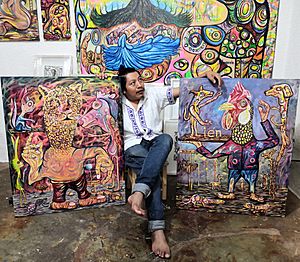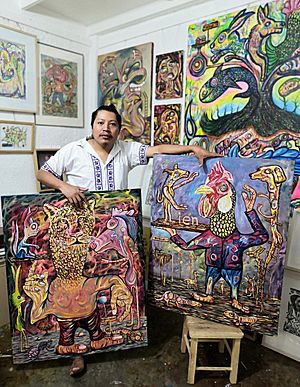Filogonio Naxín facts for kids
Quick facts for kids
Filogonio Naxín
|
|
|---|---|
 |
|
| Born |
Filogonio Velasco Casimiro
1986 (age 38–39) |
| Nationality | Mexican |
| Alma mater | UABJO |
| Known for | Drawing, painting, printing |
Filogonio Naxín (born in 1986) is a talented artist and illustrator from Mexico. He is a member of the Mazatec indigenous group. His art mixes traditional Mazatec beliefs with modern ideas. He uses his work to share Mexican indigenous languages and cultures. He also talks about important social issues of today. His art has been shown in many parts of Mexico. It has also appeared in popular magazines like Mexicanismo and Arqueología Mexicana.
About Filogonio Naxín's Life
Filogonio Naxín was born as Filogonio Velasco Casimiro. His hometown is Mazatlán de Flores. This village is in the Sierra Mazateca mountains of Oaxaca, Mexico. He grew up in a very traditional community. He did not speak Spanish until he was 11 years old. That was when he started school.
He began drawing when he was a child. One of his early inspirations was the idea of naguals. These are fantastic animal-human creatures from stories. Drawing helped him a lot in school. Especially at first, when he could not understand his teachers.
Naxín decided to go to art school. He studied at the UABJO. He graduated from there in 2005. While he was an art student, he worked many different jobs. He was a security guard, a cashier, and even a butcher. He often used waste materials from these jobs for his art projects. His studies gave him a strong background in art theory. However, they did not change his unique way of creating art.
In 2013, Naxín moved to Mexico City. But he often goes back to his hometown. He teaches art there. He believes this is an important way to help indigenous people share their voices.
Filogonio Naxín's Art Career
Naxín started showing his artwork in 2006. He also began working as an illustrator. His first big show was at the Autonomous University of Mexico City in 2013. Since then, he has had more than 30 art shows. These include both solo and group exhibitions.
His art has been displayed in many places across Mexico. Some notable venues include:
- The Instituto de Artes Gráficas in Oaxaca.
- The Centro Cultural Casa Talavera in Mexico City.
- Radio UNAM in Mexico City.
- The Museo Nacional de Culturas Populares in Mexico City.
- The Mexican Senate in Mexico City.
A lot of his work involves illustrations. He creates pictures for both children and adults. His illustrations often appear in cultural magazines and similar publications. His art started getting national attention in Mexico in 2019. This was during the International Year of Indigenous Languages.
The Style of Filogonio Naxín's Art
Drawing is still a very important part of Naxín's art. But he also uses other techniques. These include monotypes, oil paintings, watercolors, and prints.
His art combines Mazatec beliefs with modern feelings. He calls his style "social surrealism." His art often features naguals, which are animal-human figures. These figures are often shown in bright colors. Naxín believes that "all humanity is a beast." Much of his art explores the challenges of being indigenous in the modern world. He also addresses current social, political, and environmental issues.
Some important symbols in his artwork are:
- The deer, which is sacred to the Mazatec people.
- The psychotropic mushroom, made famous by María Sabina.
- Dogs and other animals.
- The horse, which Naxín sees as his personal nagual.
Using the Mazatec language is also very important to him. He uses it in the titles of his artworks and exhibitions. Sometimes, the language appears directly on the canvas or paper. He believes it is important to use indigenous languages in his work. This helps show that these languages are still alive. If only Mazatec appears, it means the artwork has one meaning for Mazatec speakers. It has a different meaning for those who do not speak the language.


